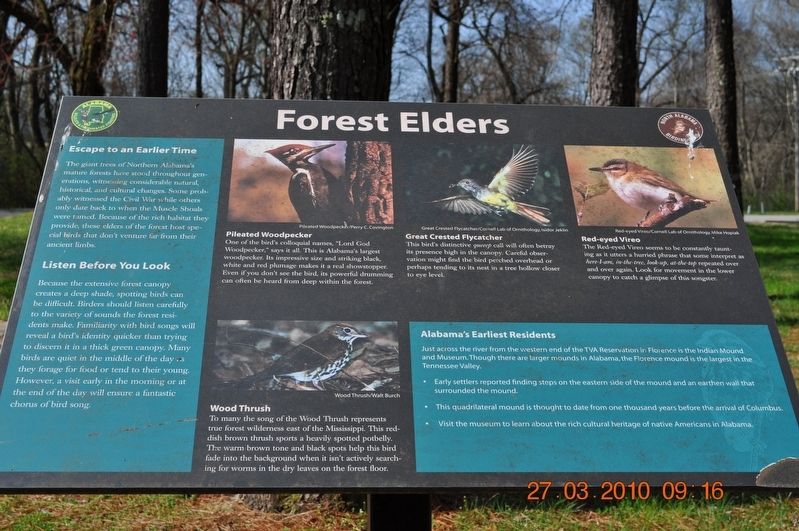Forest Elders
Escape to an Earlier Time
The giant trees of Northern Alabama's mature forest have stood throughout generations, witnessing considerable natural, historical, and cultural changes. Some probably witnessed the Civil War while others only date back to when the Muscle Shoals were tamed. Because of the rich habitat they provide, these elders of the forest host special birds that don't venture far from their ancient limbs.
Listen Before You Look
Because the extensive forest canopy creates a deep shade, spotting birds can be difficult. Birders should listen carefully to the variety of sounds the Forest residents make. Familiarity with birds songs will reveal a bird's identify quicker than trying to discern it in a thick green canopy. Many birds are quiet in the middle of the day as they forage for food or tend to their young. However, a visit early in the morning or at the end of the day will ensure a fantastic chorus of bird songs.
Pileated Woodpecker
One of the bird’s colloquial names. "Lord God Woodpecker," says it all.This is Alabama's largest woodpecker. Its impressive size and striking black, white and red plumage makes it a real showstopper. Even if you don't see the bird, its powerful drumming can often be heard from deep within the forest.
Wood Thrush
To many the song of
Great Crested Flycatcher
This birds distinctive queep call will often betray its presence high in the canopy. Careful observation might find the bird perched overhead or perhaps tending to its nest in a tree hollow closer to eye level.
Red eyed Vireo
The Red~eyed Vireo seems to be constantly taunting as it utters a hurried phrase that some interpret here~I~am, in~the~tree, look~up, at~the~top repeated over and over again. Look for movement in the lower canopy to catch a glimpse of this songster.
Alabama's Earliest Residents
Just across the river from the western end of the TVA Reservation in Florence is the Indian Mound and Museum. Though there are larger mounds in Alabama, the Florence mound is the largest in the Tennessee Valley.
• Early settlers reported finding steps on the eastern side of the mound and earthen walls that sounded the mountain
• This quadrilateral mound is thought to date from one thousand years before the arrival of Columbus
• Visit the museum to learn about the rich cultural heritage of native Americans in
Topics. This historical marker is listed in these topic lists: Animals • Environment • Horticulture & Forestry.
Location. 34° 46.822′ N, 87° 39.358′ W. Marker is in Sheffield, Alabama, in Colbert County. Marker is on Thunder Road. Marker is at TVA's Walking Trail loop, birding site #8,wildflower Garden and restrooms. Touch for map. Marker is in this post office area: Sheffield AL 35660, United States of America. Touch for directions.
Other nearby markers. At least 8 other markers are within one mile of this marker, measured as the crow flies. Old Railroad Bed (approx. 0.6 miles away); Old Railroad Bridge (approx. 0.7 miles away); Prehistoric Mound (approx. 1.1 miles away); Culture (approx. 1.1 miles away); Continuity (approx. 1.1 miles away); Removal (approx. 1.1 miles away); Adaptation (approx. 1.1 miles away); Florence Indian Mound (approx. 1.1 miles away). Touch for a list and map of all markers in Sheffield.
Also see . . .
1. Pileated Woodpecker. Habitat Pileated Woodpeckers are forest birds that require large, standing dead trees and downed wood. Forests can be evergreen, deciduous, or mixed and are often old, particularly in the West. In the East they live in young forests as well and may even be seen in partially wooded suburbs and backyards. (Submitted on July 27, 2017, by Sandra Hughes Tidwell of Killen, Alabama, USA.)
2. Wood Thrush. Habitat The Wood Thrush breeds in deciduous and mixed forests in the eastern U.S. where there are large trees, moderate understory, shade, and abundant leaf litter for foraging. They winter in lowland tropical forests in Central America. (Submitted on July 27, 2017, by Sandra Hughes Tidwell of Killen, Alabama, USA.)
3. Great Crested Flycatcher. Habitat Great Crested Flycatchers live in woodlots and open woodland, particularly among deciduous trees. On its tropical wintering grounds it occurs in similar semiopen habitats. Migrants can occur in nearly any wooded or shrubby habitat. (Submitted on July 27, 2017, by Sandra Hughes Tidwell of Killen, Alabama, USA.)
4. Red eyed Vireo. Habitat Large expanses of deciduous forest, particularly deciduous trees with large leaves (such as maples), typify Red-eyed Vireo habitat during the breeding season. On migration, look for them in nearly any type of forest, woodland, or woodlot (particularly in deciduous stands). It is often the commonest of vireo migrants. (Submitted on July 27, 2017, by Sandra Hughes Tidwell of Killen, Alabama, USA.)
Credits. This page was last revised on May 5, 2018. It was originally submitted on July 27, 2017, by Sandra Hughes Tidwell of Killen, Alabama, USA. This page has been viewed 442 times since then and 39 times this year. Last updated on May 4, 2018, by Steve Masler of Memphis, Tennessee. Photo 1. submitted on July 27, 2017, by Sandra Hughes Tidwell of Killen, Alabama, USA. • Andrew Ruppenstein was the editor who published this page.
